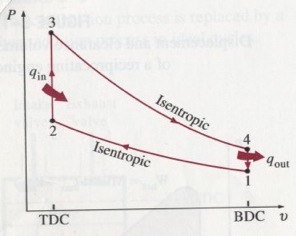Otto Cycle

The Otto cycle describes the process undergone by a typical gasoline internal combustion engine. The working fluid of the Otto cycle is a combination of fuel and air. There are four stages to a complete Otto cycle: the intake stroke, the compression stroke, the power stroke, and the exhaust stroke. The intake stroke is when the piston moves down and pulls air/fuel into the piston and then closes the intake valve. The compression stroke moves the piston upwards compressing the gas and increasing the pressure. The spark plug then ignites the air/fuel and immediately increases the pressure at a constant volume. The power stroke pushes the piston down due to the build up pressure and expands adiabatically producing work. The exhaust stroke opens the exhaust valve and returns the system to the original state of the cycle. A compression ratio “r” is defined by the expanded volume V1 of the system divided by the compressed volume V2:

The efficiency of an Otto cycle is calculated using the compression ratio:

where k is the ratio of specific heat at a constant pressure divided by the specific heat at a constant volume.
